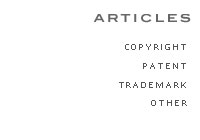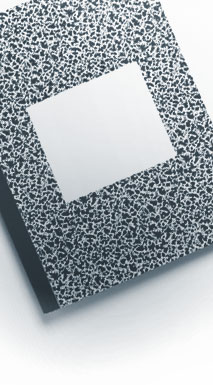

 |
||
 |
Protecting Type Font Design AIGA Journal of Graphic Design 1997 Vol. 15, No. 3 Frank J. Martinez, Esq. The essence of success in any endeavor is the ability to understand the problem to be solved. What separates artists and designers from the rest of the world is the personal nature and character of creative problem-solving. Designing a font typically requires that technical and aesthetic requirements coexist throughout the creative process and the nature of that technology makes fonts easy to acquire. My experience has shown that most font designers are hurt by pirating and in some cases even lose the rights to their work because they have yet to understand that protecting your work should be part of the creative process. In order to protect your work, all you need is a little information and some patience, and you’ll be able to safeguard your work effectively. By law, type designers in the U.S. cannot protect their work by copyright. Currently, copyright law is meant to protect the expression of a creative idea; it does not cover any object or design that is intrinsically utilitarian, which the Copyright Office considers type fonts to be. The Copyright Office will, however, protect the software as a literary work that creates the font. The Copyright Office still requires that no claim be made for the actual design of the font. There are two basic forms of legal protection for type designs in the U.S. – design patent and trademark. A typeface design can be protected by a combination of the two. A design patent is a form of patent that protects the ornamental design of an object of manufacture. Under most circumstances, a design patent is appropriate for protecting type forts and other utilitarian designs. The U.S. Patent and Trademark Office (PTO) has granted over 1,500 type or type-related design patents. The digital nature of modern type is now recognized by the Patent Office and there is no longer a requirement that a design for a font be a part of a piece of lead or filmstrip. All that is required is that the design be new, ornamental, and not an obvious variation of an existing design. A design patent is relatively simple to obtain. You don’t necessarily need a lawyer, just some patience, diligence and a basic familiarity with patent law and the rules of the Patent Office. Here are some guidelines. The font cannot have been known or used by others (i.e., generally known and accessible to the public) for more than one year prior to your filing for a U.S. patent. If you have produced copies of a font and distributed it, even on a shareware basis, for more than a year, you have rendered the font ineligible for patent protection. The courts have held that, unlike utility patents for machines, processes, or compositions of matter, a design cannot be patented even if the limited distribution was solely for the purposes of testing. However, the technical nature of digital media and the need to test across operating systems might provide sufficient reason to allow an exemption from the ban, at least in the case of type fonts. Your font will be ineligible for patent if it has been described in a printed publication (such as a type specimen catalogue) in any country for more than one year prior to your filing in the U.S. You cannot get a design patent, moreover, if the font was patented or registered in the industrial property registration of another country or organization such as the World Intellectual Property Organization (WIPO) for more than six months before the U.S. filing date. If you are a U.S. citizen or a legal resident, you should file in the U.S. first. Our law requires that the PTO issue a license to file in another country. Afterward, you can take advantage of the Patent Cooperation Treaty (PCT), through an international filing that will give you protection starting on the same date as your U.S. application. Or, if it is permitted, you can file directly in a foreign country. Check your national laws before you file in the U.S. Some countries require a national filing before a foreign one. Today, almost every industrialized country in the world is part of the Patent Cooperation Treaty. If you are not a U.S. citizen and you file within six months of the date of your foreign filing, it is possible to secure a U.S. design patent. The effective date of your protection will be the date of your foreign filing. If your home country is part of the PCT, you can take advantage of the treaty through an international PCT filing, which will give your U.S. application the same date as your national application. Your design must be novel; that is, it must be new. This has come to mean that the design cannot be an obvious variation on other designs. Of course, this is a very subjective standard, but if your design is merely an attempt to combine two or more existing faces, the result will be said to be unpatentable in view of existing designs. You will be required to submit a drawing of your design. The design may be submitted on any clean readable medium. Output from a good-quality laser printer is just as acceptable as repro from an image setter. Submit the design just as you would for a specimen catalogue, including any numerals, punctuation marks, or iconographic elements that are part of the design. You may not be able to protect the entire design. As a designer, you know that it is hard to make every shape unique—particularly punctuation marks. In such a case, the Patent Office may require that a letter or punctuation mark be removed from the application if it is nonobvious in view of an existing typeface. While you won’t be barred from marketing the font in its entirety, it probably means that your licensing ability will be limited by the extent of the design patent. When submitting an application for a patent, the emphasis is on adherence to statutory requirements for disclosure, not on particular forms. Your application must disclose information that is required by law. If all of the required information is present, the PTO will not refuse your application if it is not professionally prepared. (In contrast, the Copyright Office requires official forms.) The PTO will even give you information and official forms for design patent and/or trademark. Currently, the process of getting a design patent takes about a year. The filing and issue fees for the small entity or individual inventor total less than $400. The term of protection for a design patent is fourteen years from the date of issue. While the active life of a font may be considerably longer than fourteen years, don’t forget that any trademark that you secure will be good as long as the mark is used in commerce. The PTO also issues trademarks and service marks. A trademark is appropriate for a name that is used to identify a product or service. Accordingly, the name of a font could be trademarked. The right to a trademark arises from the actual or intended use of a mark in trade. A service mark is proper when your primary business is providing a service, not a product. Since a trademark is primarily an indicator of the source of goods or services, the proposed mark must not create the likelihood of confusion with an already existing trademark. The fee for each type or class of trademark is $245, which is sent in with the application. Unlike a design patent, however, that are maintenance fees that must be paid to keep the trademark registered. The Copyright Office will also provide you with information and official forms. The filing fee for a copyright is $20 and, unlike a patent, there is no issue fee. A copyright is valid for the life of the author plus fifty years. Now that you’ve armed yourself with some basic knowledge, you just need to notify the world that you work is protected. You can do this by marking your design or trademark. Marking is the practice of placing the words “Patent Pending” or “Pat. Pend.” On an invention or the “TM” on a mark or design that you are either using or intend to use as a trademark. Marking allows designers to exploit the commercial value of their work while an application for patent or trademark protection is being processed. There is no legal requirement that a pending design or mark be marked, but marking your design gives notice to the world that you have applied for patent protection. Federal law provides an incentive to designers by calculating damages from the date of infringement. Damages from the infringement of unmarked goods, however, are calculated from the date of notice. From a legal perspective, this is a significant issue because of the economic impact of recoverable damages. If you apply for a design patent or trademark, you should conspicuously mark your work as soon as you apply for protection. Start by marking the disk, packaging or printed matter closely associated with the sale or use of the font. Other countries may have different rules governing marking as it relates to patents trademarks and copyrights. If you have questions or concerns about proper way to protect your work, seek the services of a registered patent agent or attorney. Any opinions expressed are those of Mr. Martinez and do not reflect the policies or practices of USPTO. Patent/trademark information and forms are available from www.uspto.gov. (or telephone 800-786-9199). Copyright information and forms are available from lcweb.loc.gov/copyright (or telephone 202-707-3000).
Home Copyright Trademark Patent Litigation About Us ©2004 The Martinez Group PLLC |
 |